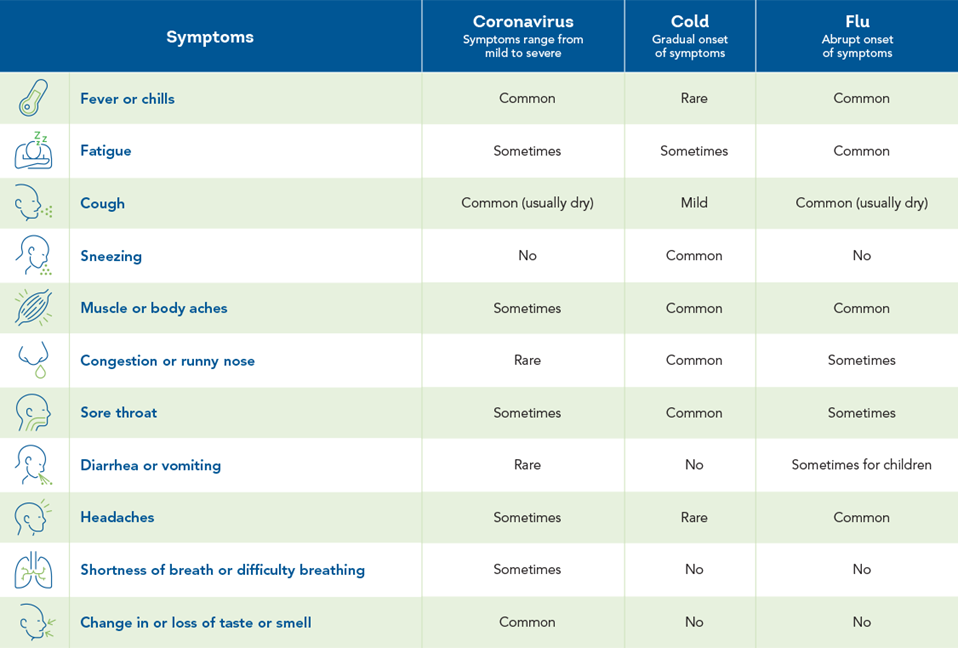Cold, flu, or COVID-19: Which one is it?
| Healthy You | Wellness

Coughing? Fever? Chills? How can you tell if you have a cold, influenza, or COVID-19? Here's how they compare.
How can you tell if you have a cold, influenza, or COVID-19? Understanding the differences in symptoms that these illnesses cause will help.
Common colds, influenza (flu), and COVID-19 are contagious respiratory illnesses caused by different viruses. Many symptoms of the three are similar, which can cause confusion about which one you may be suffering from. Contact your primary care provider to determine what care you may need, including testing to determine which, if any, virus you have.
How the three illnesses compare
COVID-19 is a highly contagious respiratory illness. COVID-19 can have varying degrees of symptoms, from none to severe. Symptoms may include fever or chills, cough, sore throat, and the loss of taste or smell. COVID-19 can cause medical complications, especially in higher-risk groups, and can result in hospitalization and death. Severe illness, such as lung injury, is more frequent with COVID-19 than with influenza. The mortality rate also is higher with COVID-19 than with the flu.
Influenza is a contagious respiratory illness that can cause mild to severe symptoms such as fever, cough, and body aches. A bad headache and fatigue—which can linger for weeks after your initial illness has passed—are hallmarks of the flu. Most people with the flu don't need medical care or medication. However, the flu can be very serious and require medical attention. Contact your doctor if your symptoms worsen, are prolonged, or if you're at high risk of flu-related complications.
You may feel pretty crummy with a common cold, but the symptoms are mild compared to viruses like the flu and COVID-19. Cold symptoms typically progress over seven to 10 days in this order: Sore throat, congestion, cough. Sniffling and sneezing are classic cold symptoms, and it's more common to experience a stuffy or runny nose with a cold than the flu. Rest and many over-the-counter medications can help relieve symptoms.
Symptoms are increasingly similar
The latest update from the Zoe Health Study, a COVID-19 symptom tracker devised by researchers at Harvard, Stanford and King's College in London, shows that COVID-19 symptoms are looking more and more like those of the flu, colds and even allergies, especially among the vaccinated.
Doctors noticed that as the omicron variant became predominant, patients experienced more upper respiratory symptoms than earlier variants. Because initial symptoms are now "influenza-like," you may need to see a doctor for testing to determine which virus you have.
The new ranking of symptoms for people who have received at least two doses of vaccine is:
- Sore throat
- Runny nose
- Blocked nose
- Persistent cough
- Headache
Reports of sneezing as a COVID-19 symptom emerged from people who'd had at least one dose of the vaccine. But sneezing was not widely reported by those who have remained unvaccinated; instead, they reported more often experiencing fever. The new ranking for the unvaccinated is:
- Headache
- Sore throat
- Runny nose
- Fever
- Persistent cough

It typically takes longer for someone to experience symptoms of COVID-19 than if they have the flu. COVID-19 symptoms generally appear two to five days after infection but could be as long as 14 days later. In contrast, flu symptoms usually appear about one to four days after infection. It's possible to be infected with the virus that causes COVID-19 or the flu without experiencing symptoms. Common cold symptoms usually appear one to three days after exposure to a cold-causing virus.
Differences in COVID-19 and influenza symptoms
So far, research indicates that a change in or the loss of taste and smell may be the only significant difference in symptoms between COVID-19 and the flu. Some people with the flu may also experience a loss of taste or smell, but it is less frequent. Because of this, you may need to see a doctor for testing to determine which virus you have.
There are a few other notable similarities and differences between influenza and COVID-19.
How the viruses spread:
- Similarities: COVID-19 and the flu can spread from person-to-person when they're within about 6 feet. Both are spread mainly by respiratory droplets when someone coughs, sneezes or talks. People may spread both before they begin showing symptoms, by people with very mild symptoms, and by people who never develop symptoms (asymptomatic).
- Differences: Although they spread similarly, COVID-19 is generally more contagious and appears to spread more quickly and easily than the flu. COVID-19 can spread to others by people before they begin showing symptoms, by people with very mild symptoms, and by people who never develop symptoms (asymptomatic).
People at higher risk for severe illness:
- Similarities: Both viruses can cause severe illness in older adults, people with certain underlying medical conditions, and pregnant people.
- Differences: Overall, COVID-19 seems to cause more severe illness in people. Some groups of people are at a higher risk for COVID-19 than others.
Complications:
- Similarities: Both COVID-19 and the flu can cause these complications:
- Pneumonia
- Respiratory failure
- Acute respiratory distress syndrome (fluid in the lungs)
- Sepsis (a life-threatening illness caused by the body's extreme response to an infection)
- Cardiac injury (heart attacks and stroke)
- Multiple-organ failure (respiratory failure, kidney failure, shock)
- Worsening of chronic conditions (involving the lungs, heart, or nervous system or diabetes)
- Inflammation of the heart, brain, or muscle tissues
- Secondary bacterial infections (infections in people who have already had the flu or COVID-19)
- Differences: COVID-19 can also cause blood clots in the lungs, heart, legs or brain and cause Multisystem Inflammatory Syndrome in Children (MIS-C) and Adults (MIS-A).
Anyone who has had COVID-19, even if their illness was mild or had no symptoms, can experience post-COVID conditions, also known as Long COVID. Post-COVID conditions are a range of symptoms that can last weeks or months after being infected with the virus that causes COVID-19 or can appear weeks after infection.
Many people with the flu or mild symptoms of COVID-19 can recover at home with rest and fluids. But some people become seriously ill from the flu or COVID-19 and must stay in the hospital.
Prevention
Stay up-to-date on your COVID-19 vaccinations and get an annual flu vaccine. Following several standard precautions can reduce your risk of infection from the viruses that cause COVID-19, colds, and the flu.
- Avoiding close contact (within 6 feet) with people who are sick.
- Self-quarantining when symptomatic.
- Wearing a face mask in indoor public spaces and outdoors, such as at a crowded event or large gathering.
- Avoiding crowded indoor spaces.
- Covering your mouth and nose with your elbow or a tissue when you cough or sneeze.
- Avoiding touching your eyes, nose, and mouth.
- Washing hands often with soap and water for at least 20 seconds.
- Cleaning and disinfecting high-touch surfaces and objects.
Treatments
There's no cure for the common cold. Treatment may include pain relievers and over-the-counter cold remedies, such as decongestants. Most people recover from a common cold in three to 10 days, although some colds may last as long as two or three weeks.
Like the cold, there are many over-the-counter remedies available. Getting an annual flu vaccine will reduce the severity of the flu and the risk of serious complications if you get sick. The vaccine is recommended for everyone six months or older and can be given as a shot or a nasal spray. In more severe cases, several antiviral drugs may be prescribed by a physician. Treatments can make the illness milder and shorten the time you are sick.
Unlike the common cold and the flu, there are only a few approved medications to treat COVID-19. Most people with COVID-19 have mild illnesses and can recover at home. You can treat symptoms with over-the-counter medicines, such as acetaminophen (Tylenol) or ibuprofen (Motrin, Advil), to help you feel better. Like the flu vaccine, staying up-to-date on your COVID-19 vaccination can also reduce the severity of COVID-19 and the risk of serious complications.
The FDA has authorized certain antiviral medications to treat mild to moderate COVID-19 in people who are more likely to get very sick. Paxlovid and Molnuoiravir are oral medications that need to be started within five days of when symptoms start.
If you have symptoms of the flu or COVID-19, contact your primary care provider to determine what care you may need, including testing to determine which, if any, virus you have.
COVID-19 and flu vaccines are widely available at many community locations, including drug stores and pharmacies. Visit vaccines.gov to find a location near you.





